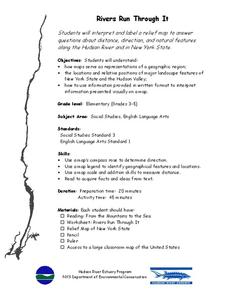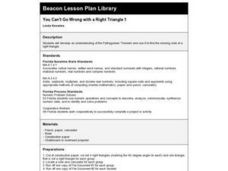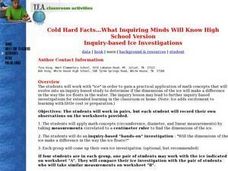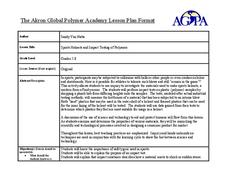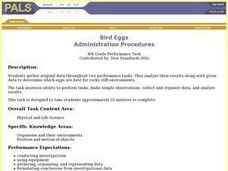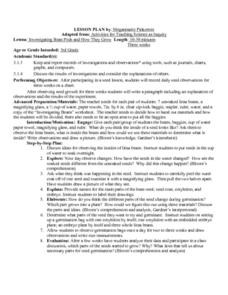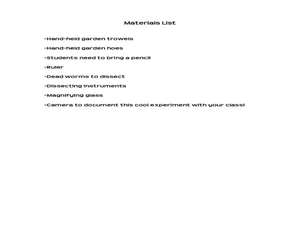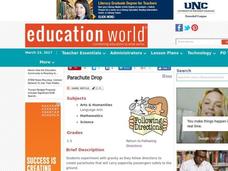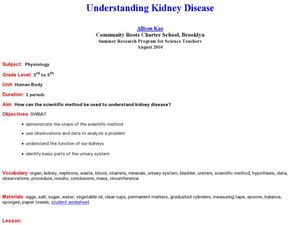Curated OER
The Laws of Sines and Cosines Made Simple!
Students study the law of sine and cosine. In this pre-calculus lesson, students create a triangle and identify the different ratios of a non-right triangle. They use the properties of sine and cosine to solve.
Curated OER
Rivers Run Through It
Using a relief map of New York State, learners answer questions about the distance between different cities, identify bodies of water, and more. First, they discuss vocabulary related to the Hudson River area. Then, they complete a...
Curated OER
How to Grow a Sunflower Plant
Students explore botany by conducting a sunflower growth experiment. In this plant life activity, students identify the anatomy of a sunflower plant and the essential nutrients it requires to grow. Students utilize compost, soil, garden...
Curated OER
You Can't Go Wrong with a Right Triangle 1
Fourth and fifth graders study the Pythagorean Theorem and apply it to find the missing side of a right triangle.
Curated OER
Do They Grow Up or Down?
Students keep a garden journal after planting a garden and discuss environmental stresses put upon the garden for growth. In this garden lesson plan, students plant the plants differently from one another and observe the outcomes.
Curated OER
Cold Hard Facts...What Inquiring Minds Will Know
Students work with "ice" in order to gain a practical application of math concepts that evolve into an inquiry-based study. They determine if the dimensions of the ice make a difference in the way the ice floats in the water.
Alabama Learning Exchange
How Old Is That Tree?
Fifth graders study environmental changes by examining the annual rings of a cross-section of a tree trunk. They access websites to complete a worksheet on the parts of a tree. They count the annual rings on a tree slice while observing...
Curated OER
Sports Helmets and Impact Testing of Polymers
Students examine the importance of good quality safety gear. In this investigative lesson, students will tests various polymers, collect data, and analyze the data to determine which polymer is best for safety helmets. They will design a...
Curated OER
Layers of the Earth: Plate Tectonics
Sixth graders participate in a lesson that is about investigating the different layers of the earth and defining how the plates move over the mantle. They engage in a variety of activities and use mathematics to create projects to...
Curated OER
The Domino Effect
Learners model the transmission of neural impulses with dominoes. In this nervous system instructional activity, students construct a device with dominoes. They use the device to model the way a nerve impulse is propagated from dendrite...
Curated OER
How Does Your Garden Grow?
Students construct and maintain a school garden. In this gardening lesson plan, students plan the construction of the garden by writing letters to local businesses asking for supplies and materials; students build the garden using their...
Curated OER
This Is a Stick Up
Learners create a sundial and track the movement of the sun throughout the day. Modifications to the lesson are provided for both lower and upper elementary students.
Curated OER
Bird Eggs
Students perform an experiment with different types of bird eggs to determine what factors make them strong and able to stay on a cliff without rolling off.
Pennsylvania Department of Education
Length and Perimeter
Third graders explore tessellations and the spatial concepts used in creating them. For this tessellations lesson, 3rd graders rotate, reflect and transform shapes to create tessellations. Students become familiar with the vocabulary...
Curated OER
Investigating Bean Pods and How They Grow
Third graders observe and create a record of seed growth over time. After planting a seed, 3rd graders record their observations of the seed's growth over a three week period. Upon conclusion of the experiment, they write a paragraph...
Curated OER
What on Earth?
Second graders investigate the different living and nonliving things they can find on Earth. In this life science lesson, 2nd graders record their observations as they dig into the soil. They examine them under the magnifying glass and...
Curated OER
Classification
Students explore the observable properties of matter and utilize them in classification. They use a binary classification system to divide objects, then justify their scheme.
Curated OER
LRO and the Apollo-11 Landing Site
In this Apollo-11 landing site activity, learners read about the NASA Lunar Reconnaissance Orbiter (LRO) that will collect images at a higher resolution than ever before. Students study a grid showing the lunar landing site from Apollo...
Curated OER
Roadkill Museum
Students use roadside kill to use taxidermy skills, become comfortable working with animals and dissecting.
Curated OER
A Science Trail: Worms
Third graders explore worms in multiple ways. In this lesson on worms, 3rd graders search for worms in their natural environment, record data on worms, and dissect worms.
Curated OER
Parachute Drop
Students explore the effects of gravity. They create a parachute and make predictions about the effect of adding weight to the bottom of the parachute. Students record and interpret results of parachute experiments.
Curated OER
NetsS.A. of Prisms
Young scholars build nets of three-dimensional prisms based on the dimensions they are given for hexagonal prism, triangular prism, rectangular prism. Working in groups, they use their prisms and calculate the Surface Area and Lateral Area.
Curated OER
Quadrilateral Attributes
Students classify quadrilaterals. In this quadrilateral lesson, students identify the characteristics of quadrilaterals. They write their findings in a journal. Students use geoboards to create quadrilaterals from given descriptions.
Curated OER
Understanding Kidney Disease
Students experiment to determine information about kidney function. In this kidney function lesson, students use the scientific method to experiment with eggs, water, salt, sugar, and vegetable oil to simulate kidney function. They...



